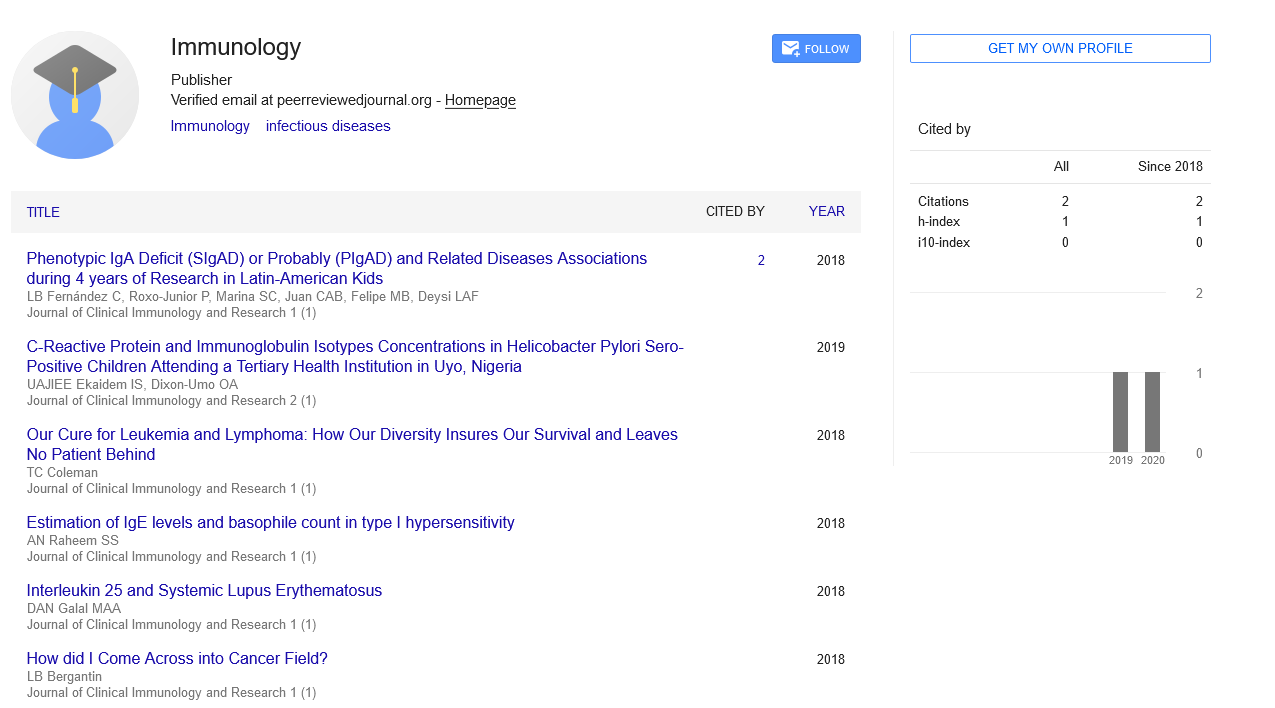Commentary, J Clin Immunol Res Vol: 4 Issue: 5
Transplant Immunology and its Dismissals
Franco Locatelli*,
Dipartimento di Scienze Pediatriche, Università di Pavia, IRCCS Policlinico San Matteo, Pavia, Italy
Corresponding Author:
Franco Locatelli
Dipartimento di Scienze Pediatriche, Università di Pavia, IRCCS Policlinico San Matteo, Pavia, Italy
E-mail: locatelli@matteo.it
Keywords: Transplantation, Xenograft, Immunology
Description
Transplantation is the most common way of moving cells, tissues, or organs, starting with one site then onto the next, either inside a similar individual or between a contributor and a beneficiary. On the off chance that an organ framework comes up short, or becomes harmed as a result of sickness or injury, it very well may be supplanted with a sound organ or tissue from a benefactor. Organ transplantation is a significant activity and is possibly offered when any remaining treatment choices have fizzled. Thusly, it isn't unexpected a day to day existence saving mediation. In 2015/16, 4,601 patient lives were saved or worked on in the UK by an organ transplant. Kidney transfers are the most widely recognized organ relocated on the NHS in the UK (3,265 of every 2015/16), trailed by the liver (925), and pancreas (230). Also, an aggregate of 383 joined heart and lung transfers were performed, while in 2015/16. Notwithstanding, entire organs are not by any means the only sort of relocate. The cornea, for instance, is the most relocated single tissue, with 5,734 methods did in 2015/16. Hematopoietic immature microorganism transplantation, regularly called Blood and Marrow Transplantation (BMT), is another normal tissue transplantation methodology. Used to treat an expansive range of illnesses, however most regularly for blood or bone marrow malignant growths like leukemia and lymphoma, around 3,600 HSCT transfers were attempted in 2012. The resistant framework assumes a basic part in transplantation. The intricate instruments of resistance, which under ordinary conditions work to distinguish unfamiliar microorganisms and direct the insusceptible framework to annihilate them, represent a critical boundary to fruitful transplantation. Dismissal of a transfer happens in cases where the safe framework recognizes the transfer as unfamiliar, setting off a reaction that will eventually obliterate the relocated organ or tissue. The force of the safe reaction against the organ or tissue, additionally ordinarily alluded to as the unite, will rely upon the sort of join being relocated and the hereditary dissimilarity between the contributor and beneficiary. To lessen the chance of dismissal, the contributor and beneficiary are painstakingly matched for resistant similarity preceding transplantation. Nonetheless, the little pool of qualified benefactors can make it hard to track down a contributor beneficiary match and there will continuously be a level of dismissal against the unite. A basic undersupply of given organs implies that sitting tight records for transfers are incredibly lengthy. Patients requiring a kidney transplantation, for instance, look out for normal 944 days (more than over two years) for a daily existence saving transplant. There were 6,943 patients enlisted for organ relocate in the UK as of March 2015. Unfortunately, 479 of these patients kicked the bucket during 2015/16 while hanging tight for a transfer due the little pool of transplantable organs. These figures underline the worth of each organ and feature the significance of an effective transplantation and keeping up with long haul relocate endurance. Control of the safe framework can uphold longterm endurance of the join guaranteeing that each relocate is pretty much as fruitful as could be expected. There are a few sorts of transplantation including tissues and organs:
Autograft: Transplantation of cells, tissues or organs between destinations inside a similar individual for example skin join.
Allograft: Transplantation of organs or tissues from a contributor to a non-hereditarily indistinguishable person of similar species. Allografts are the most widely recognized sort of relocate.
Xenograft: Transplantation of an organ or tissue between two unique species. 'Pig valves', for instance, are ordinarily used to fix or supplant a flawed heart valve in people. In 2015/16, 6,069 xenograft valve substitutions were completed in England by the NHS.iii Xenotransplantation of entire organs isn't at present feasible, in spite of the fact that it is an area of immense logical interest as an expected answer for the current basic undersupply of sufficient organs.
ABO contradictory: ABO alludes to blood bunch, which can differ between people. For most transfer types, matching of blood bunch among benefactor and beneficiary is a critical system in decreasing dismissal hazard. Nonetheless, blood bunch similarity isn't needed all the time for transplantations. For instance, on account of extremely little youngsters with juvenile insusceptible frameworks, ABO incongruent transfers can be completed with less gamble of relocate dismissal.
The Immunology of Relocate Dismissal
At the point when the insusceptible framework experiences an unfamiliar creature, it mounts an assault against it to safeguard the body from disease. To forestall an assault on our own cells and tissues (autoimmunity), the invulnerable framework should have the option to separate between our own solid tissues and unfamiliar trespassers. Unfamiliar intruders are introduced to the invulnerable framework as little atoms called antigens. Recognizable proof of these non-self antigens will set off a safe reaction and will animate the development of antigen explicit antibodies that imprint contaminated cells for annihilation by the invulnerable framework and assist with enhancing the safe reaction. The Human Leukocyte Antigen (HLA) complex is a gathering of qualities that encode the proteins liable for recognizing unfamiliar specialists to the resistant framework. These proteins are seen as on the outer layer of all cells and go about as 'self-markers' telling the insusceptible framework not to set off a reaction. Every individual will have their own particular arrangement of HLA proteins, in light of their exceptional hereditary make-up, that the safe framework will have learned not to respond to. Any cell not showing these particular HLA proteins will be recognized as 'non-self' by the resistant framework and will be treated as an unfamiliar intruder.
 Spanish
Spanish  Chinese
Chinese  Russian
Russian  German
German  French
French  Japanese
Japanese  Portuguese
Portuguese  Hindi
Hindi 